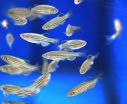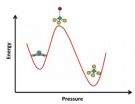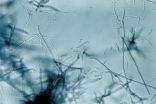(Press-News.org) We know people have lived in the New World Arctic for about 5,000 years. Archaeological evidence clearly shows that a variety of cultures survived the harsh climate in Alaska, Canada and Greenland for thousands of years. Despite this, there are several unanswered questions about these people: Where did they come from? Did they come in several waves? When did they arrive? Who are their descendants? And who can call themselves the indigenous peoples of the Arctic? We can now answer some of these questions, thanks to a comprehensive DNA study of current and former inhabitants of Greenland, Arctic Canada, Alaska, the Aleutian Islands and Siberia, conducted by an international team headed by the Centre for GeoGenetics at the Natural History Museum of Denmark, University of Copenhagen. The results have just been published in the leading scientific journal Science.
Looking for ancient human remains in northern Greenland.
The North American Arctic was one of the last major regions to be settled by modern humans. This happened when people crossed the Bering Strait from Siberia and wandered into a new world. While the area has long been well researched by archaeologists, little is known of its genetic prehistory. In this study, researchers show that the Paleo-Eskimo, who lived in the Arctic from about 5,000 years ago until about 700 years ago, represented a distinct wave of migration, separate from both Native Americans – who crossed the Bering Strait much earlier – and the Inuit, who came from Siberia to the Arctic several thousand years after the Paleo-Eskimos.
- Our genetic studies show that, in reality, the Paleo-Eskimos – representing one single group – were the first people in the Arctic, and they survived without outside contact for over 4,000 years, says Lundbeck Foundation Professor Eske Willerslev from Centre for GeoGenetics at the Natural History Museum, University of Copenhagen, who headed the study.
- Our study also shows that the Paleo-Eskimos, after surviving in near-isolation in the harsh Arctic environment for more than 4,000 years, disappeared around 700 years ago – about the same time when the ancestors of modern-day Inuit spread eastward from Alaska, adds Dr. Maanasa Raghavan of Centre for GeoGenetics and lead author of the article.
Migration pulses into the Americas
Greenlandic Inuit from the 1930s pictured in their traditional boats (umiaq), used for hunting and transportation.
In the archaeological literature, distinctions are drawn between the different cultural units in the Arctic in the period up to the rise of the Thule culture, which replaced all previous Arctic cultures and is the source of today's Inuit in Alaska, Canada and Greenland. The earlier cultures included the Saqqaq or Pre-Dorset and Dorset, comprising the Paleo-Eskimo tradition, with the Dorset being further divided into three phases. All of these had distinctive cultural, lifestyle and subsistence traits as seen in the archaeological record. There were also several periods during which the Arctic was devoid of human settlement. These facts have further raised questions regarding the possibility of several waves of migration from Siberia to Alaska, or perhaps Native Americans migrating north during the first 4,000 years of the Arctic being inhabited.
- Our study shows that, genetically, all of the different Paleo-Eskimo cultures belonged to the same group of people. On the other hand, they are not closely related to the Thule culture, and we see no indication of assimilation between the two groups. We have also ascertained that the Paleo-Eskimos were not descendants of the Native Americans. The genetics reveals that there must have been at least three separate pulses of migration from Siberia into the Americas and the Arctic. First came the ancestors of today's Native Americans, then came the Paleo-Eskimos, and finally the ancestors of today's Inuit, says Eske Willerslev.
Genetics and archaeology
The genetic study underpins some archaeological findings, but not all of them.
It rejects the speculation that the Paleo-Eskimos represented several different peoples, including Native Americans, or that they are direct ancestors of today's Inuit. Also rejected are the theories that the Greenlanders on the east coast or the Canadian Sadlermiut, from Southampton Island in Hudson Bay, who died out as late as 1902, were surviving groups of Dorset people. Genetics shows that these groups were Inuit who had developed Dorset-like cultural traits.
The study clearly shows that the diversity of tools and ways of life over time, which in archaeology is often interpreted as a result of migration, does not in fact necessarily reflect influx of new people. The Paleo-Eskimos lived in near-isolation for more than 4,000 years, and during this time their culture developed in such diverse ways that it has led some to interpret them as different peoples.
- Essentially, we have two consecutive waves of genetically distinct groups entering the New World Arctic and giving rise to three discrete cultural units. Through this study, we are able to address the question of cultural versus genetic continuity in one of the most challenging environments that modern humans have successfully settled, and present a comprehensive picture of how the Arctic was peopled, says Dr. Raghavan.
The first inhabitants
The study was unable to establish why the disappearance of the Paleo-Eskimos coincided with the ancestors of the Inuit beginning to colonise the Arctic. There is no doubt that the Inuit ancestors – who crossed the Bering Strait about 1,000 years ago and reached Greenland around 700 years ago – were technologically superior.
The Inuit's own myths tell stories of a people before them, which in all likelihood refer to the Paleo-Eskimos. In the myths, they are referred to as the 'Tunit' or 'Sivullirmiut', which means "the first inhabitants". According to these myths they were giants, who were taller and stronger than the Inuit, but easily frightened from their settlements by the newcomers.
Co-author Dr. William Fitzhugh from the Arctic Studies Centre at the Smithsonian Institution says:
- Ever since the discovery of a Paleo-Eskimo culture in the North American Arctic in 1925, archaeologists have been mystified by their relationship with the Thule culture ancestors of the modern Inuit. Paleo-Eskimo culture was replaced rapidly around AD 1300-1400, their only traces being references to 'Tunit' in Inuit mythology and adoption of some elements of Dorset technology. This new genomic research settles outstanding issues in Arctic archaeology that have been debated for nearly a century, finding that Paleo-Eskimo and Neo-Eskimo people were genetically distinct, with separate origins in Eastern Siberia, and the Paleo-Eskimo remained isolated in the Eastern Arctic for thousands of years with no significant mixing with each other or with American Indians, Norse, or other Europeans.
INFORMATION:
Contact
Eske Willerslev
Lundbeck Foundation Professor
Mobile: +45 28 75 13 09
Uffe Wilken
Communication consultant
Mobile: +45 40 18 59 92
Martin Bertelsen
Communication consultant
Mobile: + 45 24 48 21 47
New DNA study unravels the settlement history of the New World Arctic
Prehistoric migrations
2014-08-28
ELSE PRESS RELEASES FROM THIS DATE:
Penn-NIH team discover new type of cell movement
2014-08-28
VIDEO:
Penn and NIH researchers have demonstrated a never-before characterized type of cell movement. In this video, a cell's vimentin cytoskeleton (green) pulls the nucleus (red) forward to generate a high-pressure...
Click here for more information.
For decades, researchers have used petri dishes to study cell movement. These classic tissue culture tools, however, only permit two-dimensional movement, very different from the three-dimensional movements that cells make in a ...
How the zebrafish gets its stripes
2014-08-28
This news release is available in German. The zebrafish, a small fresh water fish, owes its name to a striking pattern of blue stripes alternating with golden stripes. Three major pigment cell types, black cells, reflective silvery cells, and yellow cells emerge during growth in the skin of the tiny juvenile fish and arrange as a multilayered mosaic to compose the characteristic colour pattern.
While it was known that all three cell types have to interact to form proper stripes, the embryonic origin of the pigment cells that develop the stripes of the adult fish has ...
Watching the structure of glass under pressure
2014-08-28
Glass has many applications that call for different properties, such as resistance to thermal shock or to chemically harsh environments. Glassmakers commonly use additives such as boron oxide to tweak these properties by changing the atomic structure of glass. Now researchers at the University of California, Davis, have for the first time captured atoms in borosilicate glass flipping from one structure to another as it is placed under high pressure.
The findings may have implications for understanding how glasses and similar "amorphous" materials respond at the atomic ...
Bradley Hospital collaborative study identifies genetic change in autism-related gene
2014-08-28
PROVIDENCE, R.I. – A new study from Bradley Hospital has identified a genetic change in a recently identified autism-associated gene, which may provide further insight into the causes of autism. The study, now published online in the Journal of Medical Genetics, presents findings that likely represent a definitive clinical marker for some patients' developmental disabilities.
Using whole-exome sequencing – a method that examines the parts of genes that regulate protein, called exons - the team identified a genetic change in a newly recognized autism-associated gene, Activity-Dependent ...
Yale study identifies possible bacterial drivers of IBD
2014-08-28
Yale University researchers have identified a handful of bacterial culprits that may drive inflammatory bowel diseases (IBD) such as Crohn's disease and ulcerative colitis, using patients' own intestinal immune responses as a guide.
The findings are published Aug. 28 in the journal Cell.
Trillions of bacteria exist within the human intestinal microbiota, which plays a critical role in the development and progression of IBD. Yet it's thought that only a small number of bacterial species affect a person's susceptibility to IBD and its potential severity.
"A handful ...
Drug shows promise against Sudan strain of Ebola in mice
2014-08-28
August 28, 2014 — (BRONX, NY) — Researchers from Albert Einstein College of Medicine of Yeshiva University and other institutions have developed a potential antibody therapy for Sudan ebolavirus (SUDV), one of the two most lethal strains of Ebola. A different strain, the Zaire ebolavirus (EBOV), is now devastating West Africa. First identified in 1976, SUDV has caused numerous Ebola outbreaks (most recently in 2012) that have killed more than 400 people in total. The findings were reported in ACS Chemical Biology.
Between 30 and 90 percent of people infected with Ebola ...
NASA sees a weaker Tropical Storm Marie
2014-08-28
When NOAA's GOES-West satellite captured an image of what is now Tropical Storm Marie, weakened from hurricane status on August 28, the strongest thunderstorms were located in the southern quadrant of the storm.
NOAA's GOES-West satellite captured an image of Marie on August 28 at 11 a.m. EDT. Bands of thunderstorms circled the storm especially to the north. The National Hurricane Center noted that Marie has continued to produce a small area of convection (rising air that forms the thunderstorms that make up Marie) south and east of the center during some hours on the ...
DeVincenzo study breakthrough in RSV research
2014-08-28
MEMPHIS, Tenn. – The New England Journal of Medicine published research results on Aug. 21 from a clinical trial of a drug shown to safely reduce the viral load and clinical illness of healthy adult volunteers intranasally infected with respiratory syncytial virus (RSV).
Le Bonheur Children's Hospital and the University of Tennessee Health Science Center researcher Infectious Disease Specialist John DeVincenzo, MD, is lead author of this study.
RSV is the most common cause of lower respiratory tract infections in young children in the United States and worldwide. ...
Small molecule acts as on-off switch for nature's antibiotic factory
2014-08-28
DURHAM, N.C. -- Scientists have identified the developmental on-off switch for Streptomyces, a group of soil microbes that produce more than two-thirds of the world's naturally derived antibiotic medicines.
Their hope now would be to see whether it is possible to manipulate this switch to make nature's antibiotic factory more efficient.
The study, appearing August 28 in Cell, found that a unique interaction between a small molecule called cyclic-di-GMP and a larger protein called BldD ultimately controls whether a bacterium spends its time in a vegetative state or ...
Second-hand e-cig smoke compared to regular cigarette smoke
2014-08-28
E-cigarettes are healthier for your neighbors than traditional cigarettes, but still release toxins into the air, according to a new study from USC.
Scientists studying secondhand smoke from e-cigarettes discovered an overall 10-fold decrease in exposure to harmful particles, with close-to-zero exposure to organic carcinogens. However, levels of exposure to some harmful metals in second-hand e-cigarette smoke were found to be significantly higher.
While tobacco smoke contains high levels of polycyclic aromatic hydrocarbons – cancer-causing organic compounds – the level ...
LAST 30 PRESS RELEASES:
Air pollution and depression linked with heart disease deaths in middle-aged adults
More efficient molecular motor widens potential applications
Robotic nerve ‘cuffs’ could help treat a range of neurological conditions
Researchers identify targets in the brain to modulate heart rate and treat depressive disorders
Findings of large-scale study on 572 Asian families supports gene-directed management of BRCA1 and BRCA2 gene carriers in Singapore
Many children with symptoms of brain injuries and concussions are missing out on vital checks, national US study finds
Genetic hope in fight against devastating wheat disease
Mutualism, from biology to organic chemistry?
POSTECH Professor Yong-Young Noh resolves two decades of oxide semiconductor challenges, which Is published in prestigious journal Nature
Could fishponds help with Hawaiʻi’s food sustainability?
International network in Asia and Europe to uncover the mysteries of marine life
Anthropologist documents how women and shepherds historically reduced wildfire risk in Central Italy
Living at higher altitudes in India linked to increased risk of childhood stunting
Scientists discover a new signaling pathway and design a novel drug for liver fibrosis
High-precision blood glucose level prediction achieved by few-molecule reservoir computing
The importance of communicating to the public during a pandemic, and the personal risk it can lead to
Improving health communication to save lives during epidemics
Antimicrobial-resistant hospital infections remain at least 12% above pre-pandemic levels, major US study finds
German study finds antibiotic use in patients hospitalised with COVID-19 appears to have no beneficial effect on clinical outcomes
Targeting specific protein regions offers a new treatment approach in medulloblastoma
$2.7 million grant to explore hypoxia’s impact on blood stem cells
Cardiovascular societies propel plans forward for a new American Board of Cardiovascular Medicine
Hebrew SeniorLife selected for nationwide collaborative to accelerate system-wide spread of age-friendly care for older adults
New tool helps identify babies at high-risk for RSV
Reno/Sparks selected to be part of Urban Heat Mapping Campaign
Advance in the treatment of acute heart failure identified
AGS honors Dr. Rainier P. Soriano with Dennis W. Jahnigen Memorial Award at #AGS24 for proven excellence in geriatrics education
New offshore wind turbines can take away energy from existing ones
Unprecedented research probes the relationship between sleep and memory in napping babies and young children
Job losses help explain increase in drug deaths among Black Americans
[Press-News.org] New DNA study unravels the settlement history of the New World ArcticPrehistoric migrations






